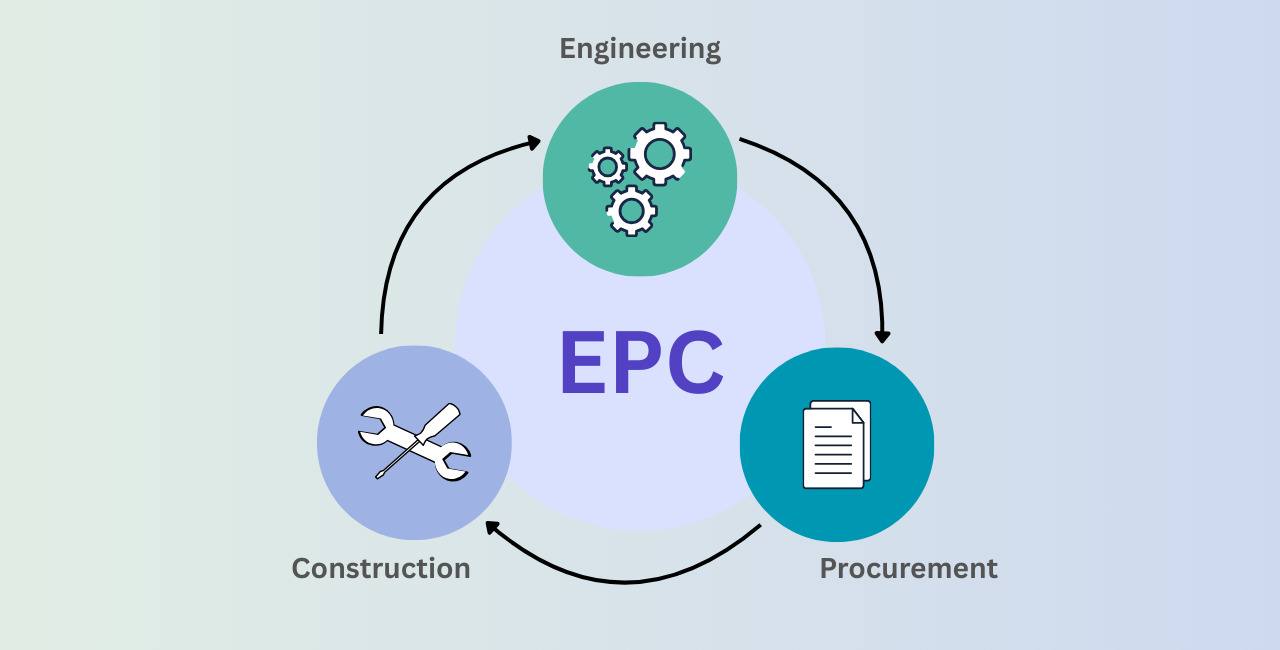
When you look into solar projects, you hear the term EPC a lot. In simple terms, it means one contractor handles the full job from start to finish.
This approach removes the stress of dealing with multiple vendors for the project owners. Instead, you rely on a single team that takes care of everything—from the first design draft to switching the system on. EPC has long been used in industries like infrastructure and oil and gas. Today, it’s becoming a go-to model in solar as well because it helps keep projects on schedule and on budget.
In this blog, we’ll explain everything related to EPC and when you should choose it.
The meaning of EPC is straightforward. It stands for Engineering, Procurement, and Construction. It describes a model where one company handles the project from start to finish.
In practice, this means the EPC contractor designs the project and buys all the needed equipment/ materials, and builds the facility until it’s ready to use. The client does not have to manage different suppliers or teams.
This model is also called a turnkey EPC project, meaning the owner can simply “turn the key” and start using the project once it’s done.
For businesses and governments, this model is attractive because it makes things simple. The EPC contractor is responsible for delivering on time and within budget and also meeting agreed performance standards.
👉 EPC in construction = one contractor designs, buys, and builds a ready-to-use project.
The EPC process usually follows a clear sequence:
Unlike other models, EPC means that the owner doesn’t need to manage each stage. The contractor coordinates everything and works under a fixed-price contract taking the risk of delays and extra costs.
👉 Think of it like hiring one company to design, shop, and build your entire house instead of dealing with separate parties.
The choice depends on how much risk and control the owner wants.


An EPC contract is built around three main phases—Engineering, Procurement, and Construction. Each phase plays a key role in making sure the project is successful.
1. Engineering-
The first phase is engineering, where the contractor focuses on design and planning. Design and planning include preparing layouts and covering all the technical details necessary to bring the project idea to life.
The contractor designs in such a way that it meets the industry and safety standards. At this stage, the client reviews the project proposal and approves it if it meets their requirements. All the technical work is left to the EPC team.
2. Procurement
The second phase is procurement, which deals with sourcing and purchasing everything needed for the project.
This includes-
The goal is to get the right materials at the right cost without delays. Since this process involves technical expertise and supplier management, the owner is not always involved. A strong procurement phase helps avoid supply chain issues and ensures smooth progress when construction begins.
3. Construction
The final phase is construction, where the project takes physical shape.
The contractor-
This phase ends with commissioning and testing so that the project works as intended. Once everything is approved, the project is officially handed over to the owner as a ready-to-use asset.
EPC contracts usually give maximum responsibility to the contractor. Most are fixed-price contracts, so the owner is protected from extra costs.
Important clauses include:
These clauses protect the owner and keep contractors accountable.
The benefits of EPC (Engineering, Procurement, and Construction) contracts are easy to see for owners who want predictable results and fewer risks.

While the EPC model offers many advantages, the project owners and contractors still face certain EPC risks. Understanding these EPC challenges is important to avoid delays and disputes.
One of the most frequent problems is scope creep. It occurs when the requirements for the project increase once the agreement has been signed. Small design modifications can create greater expenses and extended deadlines. Without established scope definitions, the conflicts are nearly unavoidable.
Another frequent challenge is cost overruns. Even though most EPC contracts are fixed-price, the unexpected changes can put pressure on contractors. This is especially true in large-scale energy projects where budgets are tight.
Supply constraints is another risk. Shortages in raw materials and shipping delays and global market fluctuations can disrupt procurement. These challenges more visible during global supply chain disruptions in recent years.
Finally, contract disputes can arise if responsibilities and performance standards or penalties are not clearly defined. Disagreements over these prospects can slow down project delivery.
EPC contracts are widely adopted across industries that demand complex and capital-intensive projects. These sectors value the single-point responsibility and efficiency that EPC construction projects bring so that timelines and budgets kept under control.
Solar EPC (Engineering, Procurement, and Construction) contracts are widely used to streamline the delivery of large-scale solar projects.
Here’s how a solar EPC works:
1. Engineering & Design
The EPC team starts with site surveys and solar irradiance studies to shape the system design. This stage covers structural layouts, electrical drawings, and a Bill of Quantities (BoQ) that lists panels, inverters, mounting systems, and all balance-of-system parts.
2. Procurement
Key equipment like modules, inverters, wiring, and mounting hardware is purchased through the EPC. Their supplier network often means better pricing and fewer risks of delivery delays.
3. Construction & Commissioning
From preparing the site to installing equipment, grid tie-in, and testing, the EPC oversees the entire build. They also make sure the project meets local codes and permit requirements. Many contracts include workmanship and performance warranties to give owners added confidence.
4. Performance & Handover
Once the system is complete, the EPC hands it over with monitoring tools and, in many cases, O&M support. Studies like those from NREL show EPC-led projects can cut soft costs by combining all these services into a single contract.

What does EPC stand for? Is EPC the same as turnkey?
EPC means Engineering, Procurement, and Construction. Many EPC projects are turnkey, but not all turnkey projects follow the EPC model.
EPC vs. EPCM—who holds design & cost risk?
In EPC, the contractor takes on design and cost risks. In EPCM, the client holds those risks while the contractor only manages.
What’s typically included in EPC services?
EPC covers system design, equipment procurement, construction, commissioning, and project handover.
How do warranties & LDs usually work?
EPC contracts often include performance warranties and LDs (penalties) if the project is delayed or underperforms.
These days, EPC projects aren’t run on messy spreadsheets or scattered files anymore. Teams now rely on software and digital tools to plan and deliver projects. From the first design sketches to the final handover the technology makes the whole process a lot more accurate.
One of the biggest game changers is BIM (Building Information Modeling). With BIM, teams can actually see a project in 3D and can spot clashes before construction starts.
This keeps engineers, contractors, and suppliers on the same page. That means fewer surprises risks and mistakes.
It’s not just about design either. Document management tools makes sure everyone is using the latest drawings and compliance records. No more digging through old versions or wasting time on outdated files—it saves headaches and keeps audits simple.
And when it comes to bidding, proposal and design the software helps EPC firms to quickly put together layouts and cost estimates that are more accurate and less time-consuming to produce.
Platforms like ARKA 360 take this further by enabling EPCs to move seamlessly from design to BoQ to proposal packages. With exportable reports, built-in version control, and consistent pricing structures, EPCs can present accurate, client-ready proposals while minimizing project risks.

The EPC model is the best option when owners need speed, cost certainty, and a single accountable partner. It reduces complexity, lowers risk, and ensures faster delivery—especially for large or technical projects like solar.
For solar developers, the process gets even better with tools like ARKA 360. With solar design software, owners can design layouts, generate BoQs, and prepare professional proposals before handing the work to an EPC contractor. This saves time and avoids costly changes, and helps EPCs deliver projects more efficiently.













